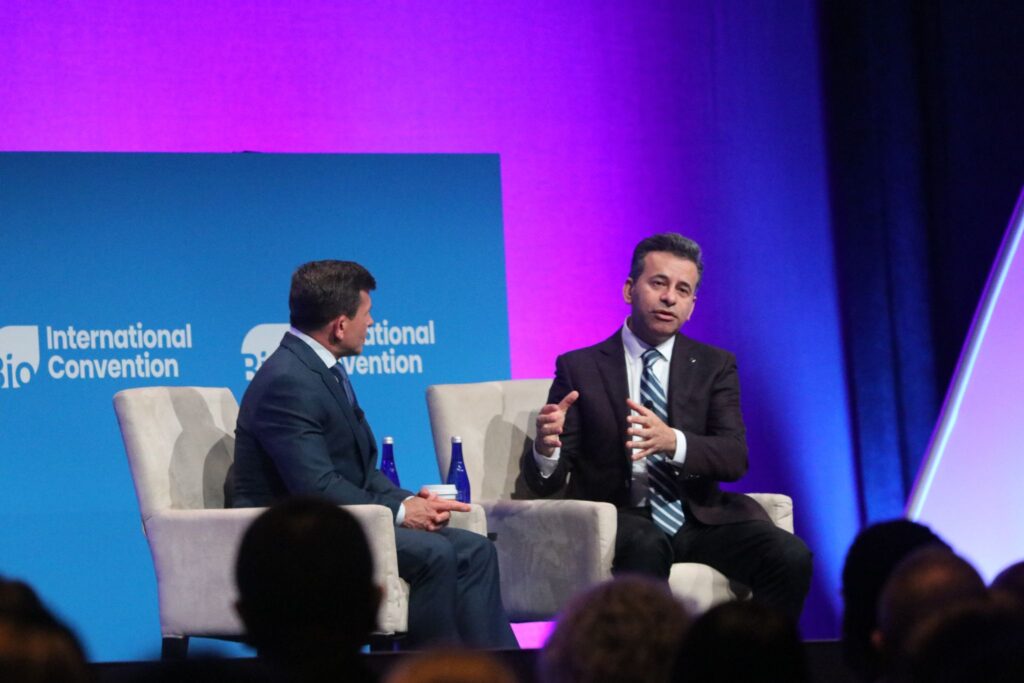![[L.-R.] John F. Crowley, President and CEO of the Biotechnology Innovation Organization (BIO), and FDA Commissioner Martin A. Makary, MD, MPH, on June 17 at the BIO International Convention held in Boston. [Biotechnology International Organization via LinkedIn]](https://www.genengnews.com/wp-content/uploads/2025/06/BIO2025-FDA-MAKARY-CROWLEY-PHOTO-1024x683.jpg)
[L.-R.] John F. Crowley, President and CEO of the Biotechnology Innovation Organization (BIO), hosts a fireside chat with FDA Commissioner Martin A. Makary, MD, MPH, at the BIO International Convention held in Boston. [Biotechnology International Organization via LinkedIn]
BOSTON—FDA Commissioner Martin Makary, MD, shared his vision for a “New FDA”—one that would decide on drug applications much faster, partner with industry, and apply artificial intelligence (AI) and big data—with biopharma leaders attending the Biotechnology Innovation Organization (BIO) International Convention, being held at the Boston Convention and Exhibition Center.
“Our focus in this FDA is very clear: Call it a New FDA. We’re going to use gold-standard science and common sense to be able to deliver more cures and meaningful treatments for Americans,” Makary declared during an hour-long fireside chat at the convention with BIO president and CEO John F. Crowley.
To fulfill that ambitious goal, Makary said, the FDA will need to ask, and eventually offer solutions, to big questions: “Why does it take over 10 years for a new drug to come to market? What systems at the FDA should be re-evaluated? Where is the wasted time in the system? I’m not talking about cutting corners on the scientific review. We’re talking about unnecessary steps, avoidable delays.”
Makary spoke hours after the FDA announced a Commissioner’s National Priority Voucher program, through which the agency will award vouchers to drug developers whose work will address a health crisis in the United States, deliver more innovative cures, address unmet public health needs, and increase domestic drug manufacturing as a national security issue.
In return, the vouchers would entitle companies to reviews of their final applications in 1–2 months rather than the current 10–12 months. Clinical data would be reviewed in a one-day meeting by a multidisciplinary team of physicians and scientists along the lines of the tumor boards that review complex cancer cases.
To get the vouchers, drug developers would have to submit the chemistry, manufacturing, and controls (CMC) portion of their application and a draft label for their treatment candidate at least 60 days before submitting their final application. The companies would have to be available for ongoing communication with prompt responses to FDA inquiries.
“We have to try new things.”
“This is a pilot program. We’re going to have to work some things out. But we have to try new things,” Makary said. “There’s a sense of urgency when you realize there’s something promising where there are wasted steps in that evaluation process. We’re going to continue to look at everything we can do to try to challenge the deeply held assumption that it does take 10 years for a new drug to come to market.”
Makary took the FDA’s helm on April 1 following nomination by President Donald Trump and confirmation by the U.S. Senate in a largely party-line 56–44 vote. Makary reports to the Secretary of Health and Human Services, Robert F. Kennedy Jr., who in April oversaw the elimination of some 10,000 jobs across HHS, including 3,500 based at the FDA, accounting for 19% of its workforce at the start of the year.
“I have reinstated people at the FDA,” Makary said without offering specifics. “And we are hiring scientific reviewers, as I think there is always a need for good scientific reviewers.” As scientific reviewer positions turn over, those positions will continue to be filled, he added.
The job cuts, he said, were planned before he took office through the Department of Government Efficiency office, once headed by Elon Musk, and did not eliminate jobs held by scientific reviewers or inspectors: “Some of the other staff had massive changes, and it’s never perfect when there are changes.”
“Tremendous” redundancies
But Makary defended the elimination of most of the positions as necessary to eliminate “tremendous” redundancies, citing as an example what he said were 12 separate travel offices and IT departments that built their own “clunky, independent” systems for reporting adverse events. One IT professional, Makary recalled, had a title and position focused on work for the Center for Drug Evaluation and Research (CDER).
“I thought, if you’re working on IT solutions for the drug evaluation process, it would be better if we thought of ourselves as a team and your solutions were available to both CDER and CBER (Center for Biologics Evaluation and Research), since both do product development,” Makary said. “There was essentially a fiefdom culture. Many different centers of the agency, sometimes they didn’t talk. Each center was autonomous. They had their own lawyers and communications staff, and legislative affairs people.”
“I do think that some of the consolidation—in fact, most of it—has been good. We did not need nearly 2,000 HR, procurement, and budget staff at the agency,” among the 19,000 FDA staffers before the cuts, Makary asserted.
The FDA cuts are intended, he said, to restore staffing to 2019 levels: “We’re probably at 2020–2021 staffing levels.”
Going forward, Makary said, the FDA will develop an internal culture that works across centers and offices: “We want to create a culture of teamwork, and we want the leaders of all the centers to have an incredible collegiality where we share resources.”
That is intended to eliminate incidents like one shared by Makary during his talk: A staffer at one center seeking to share data with a colleague at another center was not allowed to send it electronically, so he printed a stack of papers and carried it to another building where the colleague was based. “This is the sort of clunkiness that we want to get rid of.”
“Morale is good and improving at the agency. The agency is strong. And my job is to make sure that every scientist, inspector, and law enforcement official at the FDA has all the resources they need to do their job well.”
Makary also said the FDA was “on track to meet all PDUFA targets,” referring to the Prescription Drug User Fee Act through which the agency has set target dates for decisions on drug and biologics applications. But at least one drug developer has said otherwise: On Friday, KalVista Pharmaceuticals announced having been told by the agency that it would not meet its PDUFA goal date of June 17 for the company’s New Drug Application (NDA) for its oral on-demand hereditary angioedema (HAE) candidate sebetralstat “due to heavy workload and limited resources.”
Listening at BIO
Crowley disclosed that soon before Makary’s address, the commissioner met privately for a couple of hours with a group of about 115 CEOs at BIO to glean their insights into what changes they wanted to see at the FDA. It was the Boston stop on a nationwide “listening tour” consisting of private meetings by Makary and other top FDA officials with biopharma leaders in several sites, including the FDA’s White Oak campus that houses its headquarters in Silver Spring, MD, as well as San Diego and San Francisco.
“We took some heat for doing it in a closed-door fashion, but I felt strongly that I wanted unfiltered ideas on the FDA from people who interface with the FDA. And in order to do that, we wanted to create a place where you don’t have to worry about what your shareholders are going to think. You can be open and honest with us,” Makary explained.
Drug developers have asked for better communication from the agency—something Makary said he’s willing to do: “We owe it to our sponsors.”
Not all the agency’s listening has been closed-door. Earlier this month, a group of drug developers joined with researchers, molecular geneticists, immunotherapists, physicians, nonprofit directors, and patient advocates in a first-of-its-kind public roundtable discussion focused on accelerating cell and gene therapy development. Makary was joined there by Kennedy, CBER Director Vinay Prasad, MD; NIH director Jayanta (Jay) Bhattacharya, MD, PhD; and Mehmet Oz, MD, administrator for the Centers for Medicare & Medicaid Services.
“The FDA should be in partnership with industry. It should not be captured by it.” To avoid the latter, the agency has removed industry members from all FDA advisory committees where it could do so by law, and did not grant Section 502 voluntary disclosure waivers at its most recent Vaccines and Related Biologic Products Advisory Meeting on May 22.
Five “priorities”
The push for shorter reviews discussed by Makary was one of five priorities for a new FDA that he and Prasad committed to last month in a commentary published online in JAMA.
Another priority they cited is accelerating the use of AI. In April, Makary directed the agency to phase out animal testing in favor of approaches that include AI-based computational models of toxicity and cell lines, and organoid toxicity testing in a laboratory setting. And on June 2, the FDA launched its agency-wide generative AI tool Elsa, about a month ahead of schedule—and under budget, Makary said.
“One reviewer told me, this is doing in six minutes what would normally take me two or three days,” Makary said. “We’re not talking about the clinical wisdom and the judgment part. We’re talking about the mundane curation of data. These applications can be 100,000 pages for a drug.
Why such large applications?
“It’s this crazy vicious cycle where the companies want to submit everything because they don’t want us to say ‘gotcha, you didn’t include this,’” he added.
The other three priorities:
• Scrutinize Additives—The FDA has begun to define ultraprocessed foods, convened an expert panel on talc, directed the removal of all nine petroleum-based food dyes from the U.S. food supply, and begun approving novel food dyes based on natural ingredients.
• Embrace Big Data—The FDA plans to apply big data and cloud computing to study root causes of chronic diseases and monitor new drugs following approvals.
• Address High Drug Costs—The FDA will speed up reviews of generic drugs, cut red tape for developers of biosimilars, and support the “most favored nation” (MFN) approach that would lower the prices of U.S. drugs to the levels of other countries.
“The FDA will be focused on delivering faster cures and meaningful treatments for patients, especially those with neglected and rare diseases, healthier food for children, and common-sense approaches to rebuild the public trust,” Makary and Prasad declared. “The FDA and our great medical profession should unite to consider fresh new approaches to the evolving health topics facing the U.S. today.”
Previously a surgeon and public policy researcher at Johns Hopkins University, Makary had taken public positions at odds with public health leaders on vaccination schedules and measures promulgated to limit the spread of COVID-19.
Speaking at BIO, Makary said he chose to pursue a career in medicine after seeing the gratitude shown by people in his hometown of Danville, PA, to his father, a now-retired physician focused on treating rare and common hematologic conditions, first with pediatric patients and later with adult patients.



